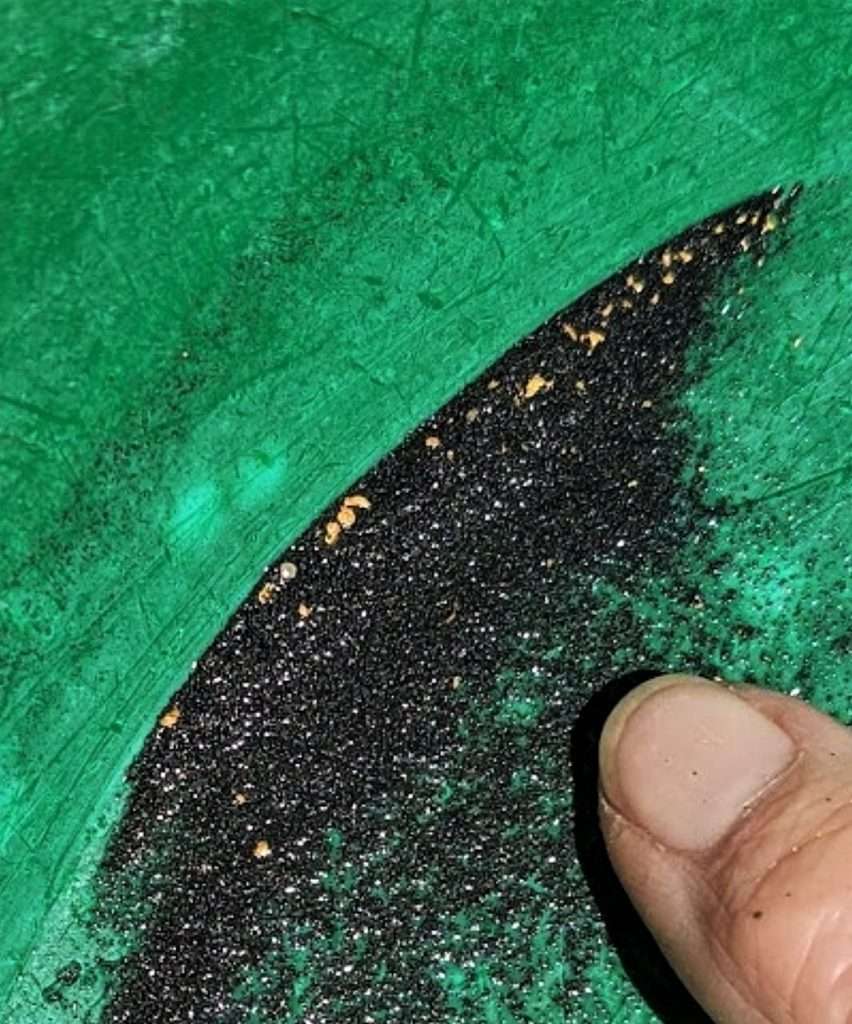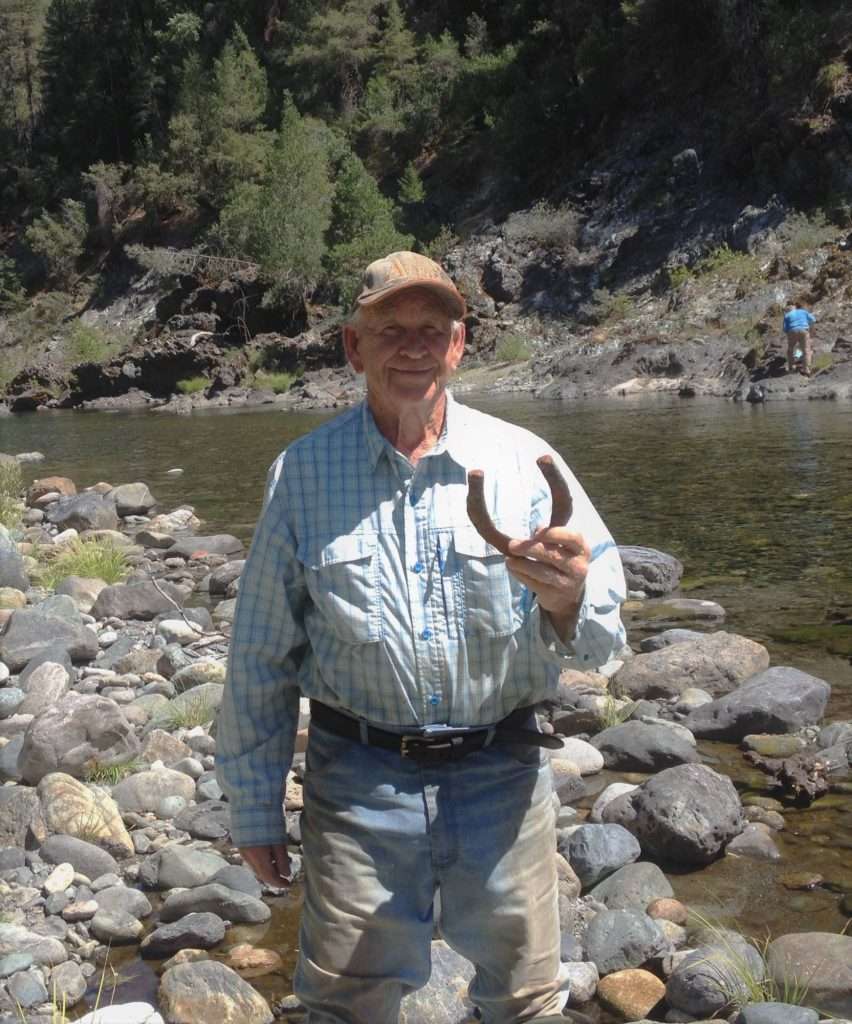Three years ago we made this exploration trip down the mountain. It was a total vertical drop of 2200 feet. That’s a long way down the mountain, off the Elliott Ranch Road near Iowa Hill California. The trail was decent but it was a long hike down and a tough way out. This trip down in 2019 was on my 80th birthday and here we are doing it again, on my 83rd. We figured a two-hour hike down and maybe a three hour hike out, if all went well.
The trail reaches the North Fork of the American River, at an area that was once a booming mining town. Now there isn’t any evidence of the townsite itself, but lots of hydraulic pits and massive areas of stacked boulders. It’s now a forest again and when we were there in 2019 we found really good gold along the river bank, not far from where the trail hit the river.



Doing this kind of hike bring up the problem of dehydration, especially in the summer and early fall. A person can go into a hike hydrated, even super hydrated, but it won’t be long before replenishing is essential. Digging, panning, and sluicing, or even detecting, burns up energy and the hot temperatures and sun steal the body moisture. We’re all guilty of pushing hard, and not drinking enough. It’s always “..just in a few minutes…” and a half hour passes. Once dehydration sets in you’re not going to solve it quickly. Doctors say once this point is reached, it will take 3-4 hours to recover completely, and that’s if you’re not doing hard physical work, like prospecting. On two recent hikes I’ve seen severe cramps set in on outstanding hikers, and once a cramp starts, it’s hard to get rid of without it re-occurring again and again. I bet some of you have been there. I have.
All this hype means, on tough hikes, you better be prepared with plenty of water and a good source of electrolytes. Just water will not always do the trick. I never thought much about electrolytes until it seemed that water just wasn’t always solving the cramping issues. I’ve done a bunch of research on this some time ago. Permit me to regress for a moment because electrolytes are so important. Here’s one description:
Electrolytes are substances that have a natural positive or negative electrical charge when dissolved in water. An adult’s body is about 60% water, which means nearly every fluid and cell in your body contains electrolytes. They help your body regulate chemical reactions, maintain the balance between fluids inside and outside your cells, and more. Your body gets electrolytes or their components from what you eat and drink. You lose electrolytes, especially when you sweat.
The reports say that we need about 2000 mg of new electrolytes per day. This will vary on each person, but that gives us something to work with.
Potassium is a very high source. One sports drink that I take with me on serious hikes is something called Body Armor. One 16-ounce bottle contains a rated 820 mg of potassium.
One trick that many of you know, especially with cramps, is to drink dill pickle juice! I shake my head at this but it works. Why? Not sure. Could it be the salt one needs?
Take some time and research this yourself.
Let’s get back to prospecting and this trip. Since this was a two-hour hike down and with a multitude of switchbacks, I decided to place marked stakes every 20 minutes on our way down. This way, as we came out, we would know how much further we had to go before we got to the beginning of the trail. In one way this sounds kind of amateurish but coming back out we sure appreciated it! It gave us hiking goals and mentally kept us on track. A 2200-foot elevation change is nothing to sneeze at.
There were five of on this trip. Two gals, Cindy and Dawn, and three guys. Jim, Dave and me. All excellent hikers and prospectors.
The trip down went pretty quick. We placed water at some of the stakes going down so we wouldn’t have to carry so much coming out. We were down in two hours on the nose!
Right off we split up. Jim was detecting, and the rest of us panning. Dave stayed on the trail side, while Dawn, Cindy and I headed across the river. The water was relatively low and crossing wasn’t a big deal. Underwater mossy rocks were the big problem, for they were very slippery. No one went down though.
I headed directly for the spot where we found good gold before. We had not cleaned it out, even though others have been there since I did the mining report in 2019. The area was a relatively small territory about 20 yards long, basically flat, and about 10 yards wide. There had been very few rocks there at the time. I knew exactly where it was, because of a trail on the other side, and a way of coming down there.
The spot was gone! Completely gone. At first I thought I was in the wrong place, surely, but I wasn’t. I ran a few pans there with very disappointing color. Where was it? What happened? Was the river so high that it took it out? Did the river remove this small bar area and take it on downstream, and replaced it with a rumble of larger cobble and debris? Did the gold gremlins mine it all out and change the structure? Not that answer but there are others who believe in gold gremlins. That’s happened to me a few times over the past 45 years of prospecting.
I couldn’t remember any outstanding storms in the past three years that would have removed this territory. It’s natural for a 100-year flood to move everything, right down to bedrock, and to move the entire bedload. When that happens a bar can be moved downstream and replaced with a bar that came from upstream. We didn’t have that kind of flood in the past three years, or did we have something like a flash flood that hits the desert area sometimes?
That idea got me to thinking about some type of very unusual storm that could have affected a major river.
One good think about the North Fork of the American is that there is only one dam downstream, called the North Fork Dam, which creates Lake Clementine. It’s fairly large. It was built as a debris dam back in 1939. Because it backs up the North Fork, and water flows over the top, the Corp of Engineers monitors the water flow, and this measurement is placed on-line so that any of us can see it. The flow is graphed and one can look back historically on it and see what has happened every day of the year.
I chose to see the past three years and to determine if there was some unusual occurrence that could have moved this streambed. At first I didn’t see it, and then I did. I isolated the charting down to several months in 2021 to get a closer look.
The graphs show the water flow in cubic feet per second (CFS). This doesn’t mean too much to me except I know to cross the river safely the CFS is around 40 or so. When we did this trip it was 42 CFS. In October 24th or so, 2021, the CFS reached 19,000 CFS. See the chart with this article. It’s a logarithmic scale. The nearest peak to this is only 10,000 CFS.
That’s a monstrous flow, almost 475 times what we feel is safe to cross the river with! No wonder that area was gone. That storm laid down over 12 inches of rain in four days, here at my place in the mountains. Now we know the answer.


We didn’t hike down this mountain to get shutout. We were finding gold and pursued it downstream some of where the bar used to be. We started picking it up again. Cindy and I were in the same territory and Dawn up stream some. She was finding some nice color up from the streambed, close to the inside of the curve and some fast water. She liked it so well she stayed there most of the remainder of the day.
Dave was doing ok on the other side and stayed in the same place too….where the shade was.
Detecting was not so great for Jim. He sure removed a lot of lead, iron, and miscellaneous targets, but gold was hard to come by.
After striking out in the first few pan samples myself, I found an old horseshoe under the water and that changed my luck. I started finding color and did for the rest of the time. I found a decent picker and lots of color, some a little larger.
Our problem was time. It was a two-hour hike down and we had maybe a three hour hike out, and we didn’t want to come out in the dark. Plus we had to add an additional hour to come out in case there were problems. That meant four hours to get out.
We reluctantly headed out early and got back to the trailhead in an amazing 2 ½ hours. That’s because I had mountain goats with me. Yep, I was the last out but not much more that 5 or 10 minutes. The next day my body knew it. I thought a truck had run over me!
This is not the end of the story though. This is just the beginning. We know there is good gold there. We just need more time. With that in mind we now have planned an overnighter for three days there and two nights. We’ll go there before October is over and we’ll come out carrying baskets of gold!
Well, maybe not that much but I hope I can bring you a follow-up story about our adventure and gold recovery.
Until soon. Don

